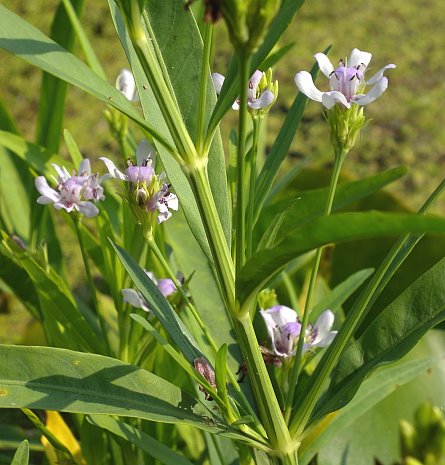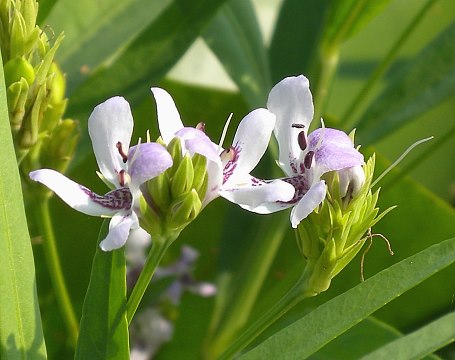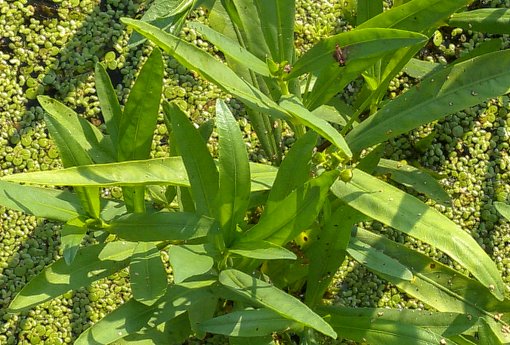
From the axils of the middle to upper leaves, there develops individual spikes of flowers on long peduncles. Each floral spike is about 1" long and capitate (head-like) in appearance; there are several overlapping flowers and buds per spike. Each flower is about ¾" across, consisting of a short-tubular corolla with 4 lobes, a short-tubular calyx with 5 teeth, 2 stamens with dark purple or dark brown anthers, and an ovary with a slender white style. The corolla has a shallowly notched upper lobe that curves backward, 2 lateral lobes that are widely spreading, and a lower lobe that curves slightly downward. Except for the dark purple mottling at the base of the lower lobe, the lobes are mostly white, otherwise they are tinted pale purple or they are lightly speckled with fine purple dots. The lobes of the corolla are longer than the corolla tube, and they are oblong to oblong-oblanceolate in shape. The green calyx is about ¼" long and glabrous; its teeth are narrowly lanceolate. The ascending straight peduncles are a little shorter to about as long as the leaves (up to 6" in length); they are medium green, angular, and glabrous. The blooming period occurs from early summer into the fall, lasting about 2-4 months. Usually, only a few flowers are in bloom at the same time. Afterwards, the flowers are replaced by seed capsules up to ½" long that taper to stipe-like bases. Each capsule has 2 cells, and each cell contains 2 seeds. The seeds are about 1/8" (3 mm.) in length and warty. The root system is highly rhizomatous, forming colonies of plants.

Cultivation: The preference is full or partial sun, shallow standing water (up to 3' deep) or wet conditions, and soil that is muddy, sandy, or gravelly.
Range & Habitat: The native Water Willow is occasional in most areas of Illinois, except the NW section of the state, where it is uncommon or absent (see Distribution Map). Habitats include sandbars, gravelbars, or mudbars of rivers, low islands in rivers or ponds, shallow water or muddy banks of ponds and rivers, shallow water of rocky upland streams, shallow water or wet areas of swamps, and sandy marshes. Water Willow occurs in wetlands with either stagnant water or slow to moderate currents of water.
Faunal Associations: The flowers are cross-pollinated primarily by bees, including honeybees, bumblebees, Anthophorine bees (Anthophora spp.), little carpenter bees (Ceratina spp.), cuckoo bees (Epeolus spp., Triepeolus spp.), long-horned bees (Melissodes spp., Synhalonia spp.), leaf-cutter bees (Megachile spp.), green metallic bees, and other Halictid bees. Other floral visitors include various wasps, bee flies (Bombyliidae), thick-headed flies (Conopidae), Syrphid flies (non-pollinating), small butterflies, and skippers. These insects obtain primarily nectar from the flowers, although some bees collect pollen and some flies feed on pollen. Water Willow is one of the host plants for the caterpillars of Darapsa versicolor (Hydrangea Sphinx); they feed on the foliage. This plant is also a minor source of food for muskrats.

Photographic Location: A sandy marsh at the Heron Boardwalk in Vermilion County, Illinois.
Comments: The flowers of Water Willow are fairly showy and bloom intermittently for a long period of time. In spite of its common name, this is a non-woody herbaceous plant that is not closely related to willows (Salix). Water Willow is the most northern member of its genus. Another species that can be found in southern Illinois, Justicia ovata (Southern Water Willow), is a slightly smaller plant with wider leaves and more loosely flowered spikes. Otherwise, these two species have a similar appearance and prefer similar habitats. A scientific synonym of Water Willow is Dianthera americana.